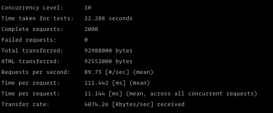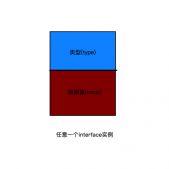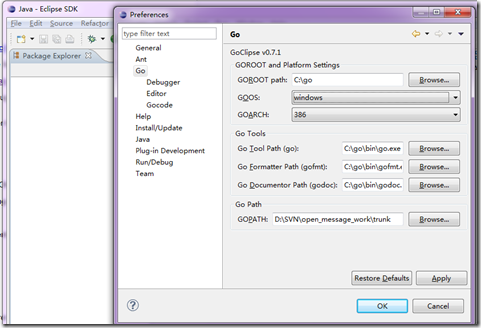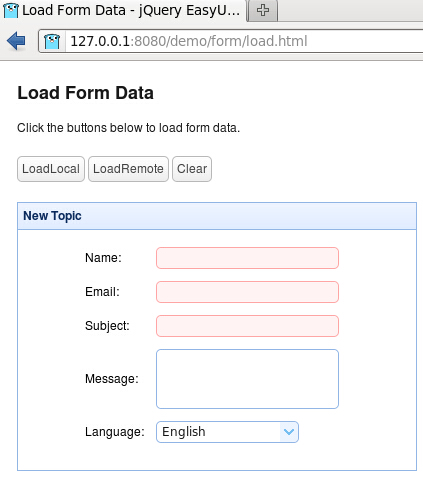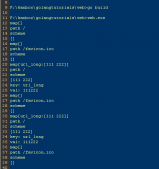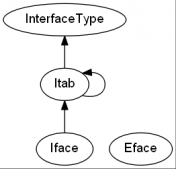结构体struct
struct 用来自定义复杂数据结构,可以包含多个字段(属性),可以嵌套;
go中的struct类型理解为类,可以定义方法,和函数定义有些许区别;
struct类型是值类型。
struct定义
|
1
2
3
4
5
|
type User struct { Name string Age int32 mess string} |
|
1
2
3
|
var user Uservar user1 *User = &User{}var user2 *User = new(User) |
struct使用
下面示例中user1和user2为指针类型,访问的时候编译器会自动把 user1.Name 转为 (*user1).Name
|
1
2
3
4
5
6
7
8
9
10
11
12
13
14
15
16
17
18
19
|
func main() { var user User user.Name = "nick" user.Age = 18 user.mess = "lover" var user1 *User = &User{ Name: "dawn", Age: 21, } fmt.Println(*user1) //{dawn 21 } fmt.Println(user1.Name, (*user1).Name) //dawn dawn var user2 *User = new(User) user2.Name = "suoning" user2.Age = 18 fmt.Println(user2) //&{suoning 18 } fmt.Println(user2.Name, (*user2).Name) //suoning suoning} |
构造函数
golang中的struct没有构造函数,可以伪造一个
|
1
2
3
4
5
6
7
8
9
10
11
12
13
14
15
|
type User struct { Name string Age int32 mess string}func NewUser(name string, age int32, mess string) *User { return &User{Name:name,Age:age,mess:mess}}func main() { //user := new(User) user := NewUser("suoning", 18, "lover") fmt.Println(user, user.mess, user.Name, user.Age)} |
内存布局
struct中的所有字段在内存是连续的
|
1
2
3
4
5
6
7
8
9
|
var user User user.Name = "nick" user.Age = 18 user.mess = "lover" fmt.Println(user) //{nick 18 lover} fmt.Printf("Name:%p\n", &user.Name) //Name:0xc420016180 fmt.Printf("Age: %p\n", &user.Age) //Age: 0xc420016190 fmt.Printf("mess:%p\n", &user.mess) //mess:0xc420016198 8字节为内存对齐 |
方法
方法是作用在特定类型的变量上,因此自定义类型,都可以有方法,而不仅仅是struct。
方法的访问控制也是通过大小写控制。
init函数是通过传入指针实现,这样改变struct字段值,因为是值类型。
|
1
2
3
4
5
6
7
8
9
10
11
12
13
14
15
16
17
18
19
20
21
22
23
|
type User struct { Name string Age int sex string}func (this *User) init(name string, age int, sex string) { this.Name = name this.Age = age this.sex = sex}func (this User) GetName() string { return this.Name}func main() { var user User user.init("nick", 18, "man") //(&user).init("nick", 18, "man") name := user.GetName() fmt.Println(name)} |
匿名字段
如果有冲突的, 则最外的优先
|
1
2
3
4
5
6
7
8
9
10
11
|
type User struct { Name stirng Age int }type Lover struct { User sex time.Time int Age int} |
继承 & 多重继承
一个结构体继承多个结构体,访问通过点。继承字段以及方法。
可以起别名,如下面 u1(user1),访问 user.u1.Age。
如果继承的结构体都拥有同一个字段,通过user.name访问就会报错,必须通过user.user1.name来访问。
|
1
2
3
4
5
6
7
8
9
10
11
12
13
14
15
16
17
18
19
20
21
22
23
24
|
type user1 struct { name string Age int}type user2 struct { name string age int sex time.Time}type User struct { u1 user1 //别名 user2 Name string Age int}func main() { var user User user.Name = "nick" user.u1.Age = 18 fmt.Println(user) //{{ 18} { 0 {0 0 <nil>}} nick 0}} |
tag
在go中,首字母大小写有特殊的语法含义,小写包外无法引用。由于需要和其它的系统进行数据交互,例如转成json格式。这个时候如果用属性名来作为键值可能不一定会符合项目要求。tag在转换成其它数据格式的时候,会使用其中特定的字段作为键值。
|
1
2
3
4
5
6
7
8
9
10
11
12
13
14
15
|
import "encoding/json"type User struct { Name string `json:"userName"` Age int `json:"userAge"`}func main() { var user User user.Name = "nick" user.Age = 18 conJson, _ := json.Marshal(user) fmt.Println(string(conJson)) //{"userName":"nick","userAge":0}} |
String()
如果实现了String()这个方法,那么fmt默认会调用String()。
|
1
2
3
4
5
6
7
8
9
10
11
12
13
14
15
16
|
type name1 struct { int string}func (this *name1) String() string { return fmt.Sprintf("This is String(%s).", this.string)}func main() { n := new(name1) fmt.Println(n) //This is String(). n.string = "suoning" d := fmt.Sprintf("%s", n) //This is String(suoning). fmt.Println(d)} |
接口Interface
Interface类型可以定义一组方法,但是这些不需要实现。并且interface不能包含任何变量。
interface类型默认是一个指针。
Interface定义
|
1
2
3
4
5
|
type Car interface { NameGet() string Run(n int) Stop()} |
Interface实现
Golang中的接口,不需要显示的实现。只要一个变量,含有接口类型中的所有方法,那么这个变量就实现这个接口。因此,golang中没有implement类似的关键字;
如果一个变量含有了多个interface类型的方法,那么这个变量就实现了多个接口;如果一个变量只含有了1个interface的方部分方法,那么这个变量没有实现这个接口。
空接口 Interface{}:空接口没有任何方法,所以所有类型都实现了空接口。
|
1
2
3
|
var a intvar b interface{} //空接口b = a |
多态
一种事物的多种形态,都可以按照统一的接口进行操作。
栗子:
|
1
2
3
4
5
6
7
8
9
10
11
12
13
14
15
16
17
18
19
20
21
22
23
24
25
26
27
28
29
30
31
32
33
34
35
36
37
38
39
40
41
42
43
44
45
46
47
48
49
50
51
52
|
type Car interface { NameGet() string Run(n int) Stop()}type BMW struct { Name string}func (this *BMW) NameGet() string { return this.Name}func (this *BMW) Run(n int) { fmt.Printf("BMW is running of num is %d \n", n)}func (this *BMW) Stop() { fmt.Printf("BMW is stop \n")}type Benz struct { Name string}func (this *Benz) NameGet() string { return this.Name}func (this *Benz) Run(n int) { fmt.Printf("Benz is running of num is %d \n", n)}func (this *Benz) Stop() { fmt.Printf("Benz is stop \n")}func (this *Benz) ChatUp() { fmt.Printf("ChatUp \n")}func main() { var car Car fmt.Println(car) // <nil> var bmw BMW = BMW{Name: "宝马"} car = &bmw fmt.Println(car.NameGet()) //宝马 car.Run(1) //BMW is running of num is 1 car.Stop() //BMW is stop benz := &Benz{Name: "大奔"} car = benz fmt.Println(car.NameGet()) //大奔 car.Run(2) //Benz is running of num is 2 car.Stop() //Benz is stop //car.ChatUp() //ERROR: car.ChatUp undefined (type Car has no field or method ChatUp)} |
Interface嵌套
一个接口可以嵌套在另外的接口。
即需要实现2个接口的方法。
|
1
2
3
4
5
6
7
8
9
10
|
type Car interface { NameGet() string Run(n int) Stop()}type Used interface { Car Cheap()} |
类型断言
类型断言,由于接口是一般类型,不知道具体类型,
如果要转成具体类型,可以采用以下方法进行转换:
|
1
2
3
4
5
6
|
var t intvar x interface{}x = ty = x.(int) //转成inty, ok = x.(int) //转成int,不报错 |
栗子一:
|
1
2
3
4
5
6
7
8
9
10
11
12
13
14
15
|
func test(i interface{}) { // n := i.(int) n, ok := i.(int) if !ok { fmt.Println("error") return } n += 10 fmt.Println(n)}func main() { var t1 int test(t1)} |
栗子二:
|
1
2
3
4
5
6
7
8
9
10
11
12
13
14
15
16
17
18
19
20
21
22
23
24
25
26
27
28
29
30
|
switch & typetype Student struct { Name string}func judgmentType(items ...interface{}) { for k, v := range items { switch v.(type) { case string: fmt.Printf("string, %d[%v]\n", k, v) case bool: fmt.Printf("bool, %d[%v]\n", k, v) case int, int32, int64: fmt.Printf("int, %d[%v]\n", k, v) case float32, float64: fmt.Printf("float, %d[%v]\n", k, v) case Student: fmt.Printf("Student, %d[%v]\n", k, v) case *Student: fmt.Printf("Student, %d[%p]\n", k, v) } }}func main() { stu1 := &Student{Name: "nick"} judgmentType(1, 2.2, "learing", stu1)} |
栗子三:
判断一个变量是否实现了指定接口
|
1
2
3
4
5
6
7
8
9
10
11
12
13
14
15
16
17
18
19
20
21
22
23
|
type Stringer interface { String() string}type Mystruct interface {}type Mystruct2 struct {}func (this *Mystruct2) String() string { return ""}func main() { var v Mystruct var v2 Mystruct2 v = &v2 if sv, ok := v.(Stringer); ok { fmt.Printf("%v implements String(): %s\n", sv.String()); }} |
反射 reflect
reflect包实现了运行时反射,允许程序操作任意类型的对象。
典型用法是用静态类型interface{}保存一个值,
通过调用TypeOf获取其动态类型信息,该函数返回一个Type类型值。
调用ValueOf函数返回一个Value类型值,该值代表运行时的数据。
func TypeOf(i interface{}) Type
TypeOf返回接口中保存的值的类型,TypeOf(nil)会返回nil。
func ValueOf(i interface{}) Value
ValueOf返回一个初始化为i接口保管的具体值的Value,ValueOf(nil)返回Value零值。
reflect.Value.Kind
获取变量的类别,返回一个常量
|
1
2
3
4
5
6
7
8
9
10
11
12
13
14
15
16
17
18
19
20
21
22
23
24
25
26
27
28
29
30
31
|
const ( Invalid Kind = iota Bool Int Int8 Int16 Int32 Int64 Uint Uint8 Uint16 Uint32 Uint64 Uintptr Float32 Float64 Complex64 Complex128 Array Chan Func Interface Map Ptr Slice String Struct UnsafePointer)reflect.Value.Kind()方法返回的常量 |
reflect.Value.Interface()
转换成interface{}类型
【变量<-->Interface{}<-->Reflect.Value】
获取变量的值:
|
1
2
3
4
|
reflect.ValueOf(x).Int()reflect.ValueOf(x).Float() reflect.ValueOf(x).String()reflect.ValueOf(x).Bool() |
通过反射的来改变变量的值
|
1
2
3
4
|
reflect.Value.SetXX相关方法,比如:reflect.Value.SetInt(),设置整数reflect.Value.SetFloat(),设置浮点数reflect.Value.SetString(),设置字符串 |
栗子一
|
1
2
3
4
5
6
7
8
9
10
11
12
13
14
15
16
17
|
import "reflect"func main() { var x float64 = 5.21 fmt.Println("type:", reflect.TypeOf(x)) //type: float64 v := reflect.ValueOf(x) fmt.Println("value:", v) //value: 5.21 fmt.Println("type:", v.Type()) //type: float64 fmt.Println("kind:", v.Kind()) //kind: float64 fmt.Println("value:", v.Float()) //value: 5.21 fmt.Println(v.Interface()) //5.21 fmt.Printf("value is %1.1e\n", v.Interface()) //value is 5.2e+00 y := v.Interface().(float64) fmt.Println(y) //5.21} |
栗子二(修改值)
SetXX(x) 因为传递的是 x 的值的副本,所以SetXX不能够改 x,改动 x 必须向函数传递 x 的指针,SetXX(&x) 。
|
1
2
3
4
5
6
7
8
|
//错误代码!!!//panic: reflect: reflect.Value.SetFloat using unaddressable valuefunc main() { var a float64 fv := reflect.ValueOf(&a) fv.SetFloat(520.00) fmt.Printf("%v\n", a)} |
|
1
2
3
4
5
6
7
|
//正确的,传指针func main() { var a2 float64 fv2 := reflect.ValueOf(&a2) fv2.Elem().SetFloat(520.00) fmt.Printf("%v\n", a2) //520} |
反射操作结构体
reflect.Value.NumField()获取结构体中字段的个数
reflect.Value.Method(n).Call(nil)来调用结构体中的方法
栗子一(通过反射操作结构体)
|
1
2
3
4
5
6
7
8
9
10
11
12
13
14
15
16
17
18
19
20
21
22
23
24
25
26
27
28
29
30
|
import "reflect"type NotknownType struct { S1 string S2 string S3 string}func (n NotknownType) String() string { return n.S1 + " & " + n.S2 + " & " + n.S3}var secret interface{} = NotknownType{"Go", "C", "Python"}func main() { value := reflect.ValueOf(secret) fmt.Println(value) //Go & C & Python typ := reflect.TypeOf(secret) fmt.Println(typ) //main.NotknownType knd := value.Kind() fmt.Println(knd) // struct for i := 0; i < value.NumField(); i++ { fmt.Printf("Field %d: %v\n", i, value.Field(i)) } results := value.Method(0).Call(nil) fmt.Println(results) // [Go & C & Python]} |
栗子二(通过反射修改结构体)
|
1
2
3
4
5
6
7
8
9
10
11
12
13
14
15
16
17
18
19
20
21
22
23
24
25
26
27
28
29
|
import "reflect"type T struct { A int B string}func main() { t := T{18, "nick"} s := reflect.ValueOf(&t).Elem() typeOfT := s.Type() for i := 0; i < s.NumField(); i++ { f := s.Field(i) fmt.Printf("%d: %s %s = %v\n", i, typeOfT.Field(i).Name, f.Type(), f.Interface()) } s.Field(0).SetInt(25) s.Field(1).SetString("nicky") fmt.Println(t)}/*输出:0: A int = 181: B string = nick{25 nicky}*/ |
|
1
2
3
4
5
6
7
8
9
10
11
12
13
14
15
16
17
18
19
20
21
|
import "reflect"type test struct { S1 string s2 string s3 string}var s interface{} = &test{ S1: "s1", s2: "s2", s3: "s3",}func main() { val := reflect.ValueOf(s) fmt.Println(val) //&{s1 s2 s3} fmt.Println(val.Elem()) //{s1 s2 s3} fmt.Println(val.Elem().Field(0)) //s1 val.Elem().Field(0).SetString("hehe") //S1大写} |
栗子三(struct tag 内部实现)
|
1
2
3
4
5
6
7
8
9
10
11
12
13
14
15
16
17
|
package mainimport ( "fmt" "reflect")type User struct { Name string `json:"user_name"`}func main() { var user User userType := reflect.TypeOf(user) jsonString := userType.Field(0).Tag.Get("json") fmt.Println(jsonString) //user_name} |
以上这篇浅谈Go语言中的结构体struct & 接口Interface & 反射就是小编分享给大家的全部内容了,希望能给大家一个参考,也希望大家多多支持服务器之家。





